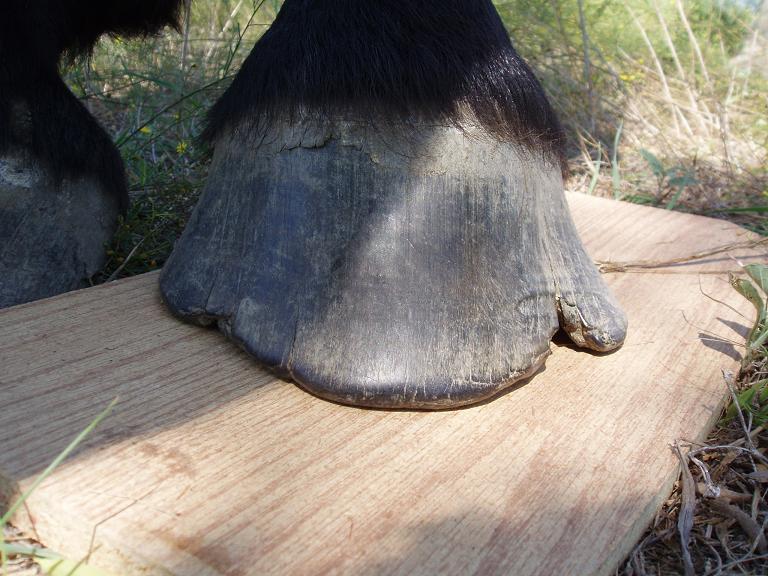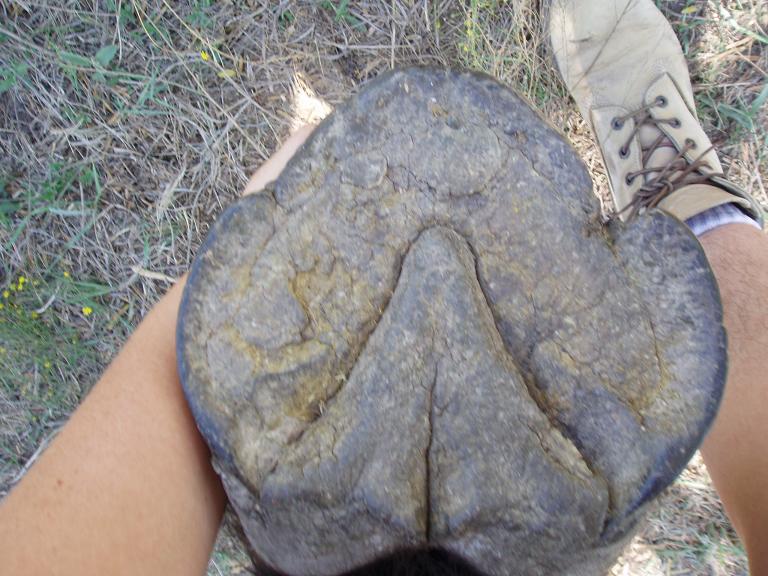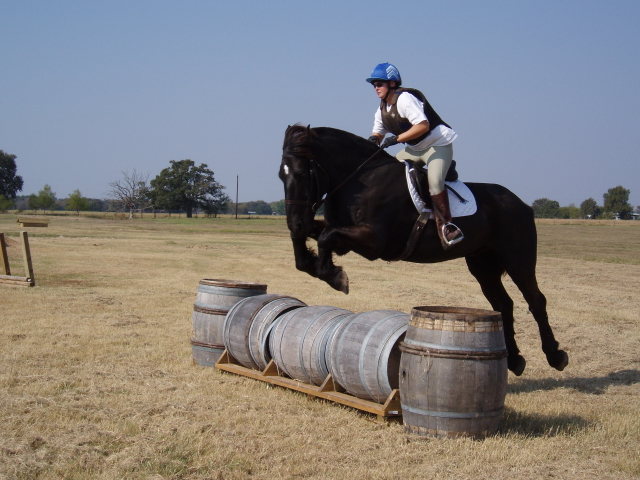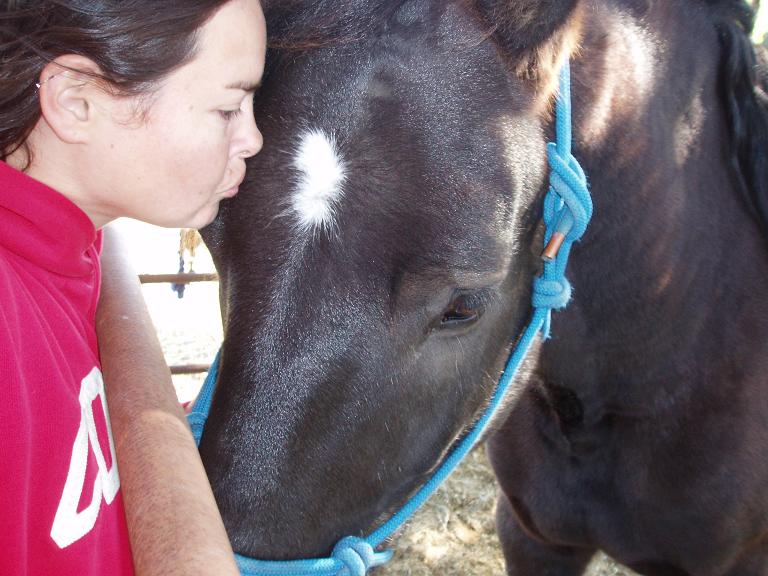The long awaited trimming post has arrived! I am going to detail as much of the trim as I can, considering I am not the primary trimmer. I will relay any specific questions to the main trimmer and answer them as best I can.
To my knowledge, Brego has never worn shoes. Or if he has, it was very early in his life. I know his history from 3 years old and on, and he has been barefoot the entire time. When I bought him, he would not pick up his feet and his hooves were extremely overgrown. His previous owners had taken good care of him, and he was in a good weight, but his feet were pretty neglected, with severe flaring all around the hoof capsule, from the toe to the heel.
In his third year, before I got him, he was housed on a sand paddock and not ridden at all. In fact, the people I bought him from were pretty intimidated by him. They told me the story that the people they had bought him from said he bucked under saddle so they never really worked with him. The end result was that his feet continued to flare on the soft ground and there was no natural wearing or chipping action to help alleviate the overgrowth.
When I bought him, I knew very little about feet. I noticed he had no contraction of his heel and nice large frog and was largely satisfied. My first few trims were a learning process, where I just trimmed his hoof wall back to stop the flaring and did little to balance his foot overall. He has always been sound, even with the incredibly long feet, and he was sound after my trims so I was not too concerned. During the first year and a half that I owned him, he was turned out on 80 acres of black-land prairie which gets quite hard in dry conditions. He was in a large herd of horses so he moved around quite a bit, and I think that had a lot to do with his feet remaining good and sound, even with my uneducated trim.
Last January, I moved him to a "better" facility which had arenas and jumps for training, but he was in an enclosed paddock, just 2 acres, with 7 other horses and 3 donkeys. The ground was terrible, a thick mud, and the paddock was never picked, so he ended up standing in manure and urine and had very little movement. I fought with the barn owner for turnout, as they had originally advertised, and I was lucky if he got turned out into a 10 acre pasture for a few hours five days a week. His feet completely degraded and he lost a lot of conditioning. His hoof wall would flake and peel, completely corroded, and his sole dropped to the ground. He lost the concavity his feet had gained the previous two years. For the first time, he started to be sore over rocks. It was during this time that I found a better trimmer for him, since I doubted my ability to keep him going under those conditions.
Last August, I moved him to a new facility, where he has a 7 acre grass pasture that he shares with only Hobby. This means that with proper rain, the pasture will continue to hold grass and not descend into a muddy hole. He also has more movement, although not nearly as much as he had in the herd environment on 80 acres. His exercise level has vastly increased, as he has come of age and I have put him into serious training. It has taken about 6 months of careful conditioning over rocky trails to begin to get back some of his ability. He still gets foot sore if the rocks are too big, but he can handle a typical Hill Country trail for 12 miles at least, when his feet are dry.
I have included this information, because environment is 50% of the battle with keeping a horse comfortable barefoot. There are some environments where a horse cannot be barefoot, no matter how good the trimming or how naturally predisposed the hoof is. Very prolonged wet conditions, or conditions where the horse cannot have adequate turnout really work against the natural mechanisms needed to keep the hoof healthy. Also, the goals of the rider are also a factor. If the rider desires the horse to be able to go 50 miles over rocks barefoot, then they must expend considerable energy conditioning and acclimating the horse to rocks. It is possible, but it's very hard. Better to go with shoes or boots to protect the non-acclimated hoof. If the goal of the rider are to be sound in a sandy arena and well groomed cross country course, the conditioning is much less severe, but traction must always be a consideration.
I have ridden Brego in knee high wet grass at a canter and never felt a slip, but I would certainly scratch before I did any jumping or speed work at a competition in those conditions. It's about priorities and being realistic. I believe a well conditioned barefoot horse gives me the most options: I can put on boots (if they will fit), I can put on shoes for studs, I can leave him barefoot, etc. So I try to keep him barefoot and progressing, but I am very realistic about his abilities. Once you put shoes on full time and lose the natural conditioning, you must stay with shoes or boots and you have fewer options. Not a big deal for full-time show competitors, but a big deal for me because I have many interests and activities with Brego.
I won't go into all the arguments for or against barefoot, just say that I have done my research and am seeing how things go. I am not close minded one way or the other, and Brego will tell me what he needs to be comfortable.
Ok on to the trim, which was performed on December 17, 2007 (Click on the pictures to see larger versions):
Here are Brego’s feet pre-trim.
He toes in significantly, which is common in draft horses. His is also base narrow and tends to paddle. Draft horses are purposely bred this way so they can walk comfortably in a furrow. Great for plowing, not so great for everything else.
His feet are 7.5 inches in width and slightly less in length, which is why most boots do not fit. Most horses feet are longer than wide, but Brego and a couple of the other drafts I have known are the opposite. These boots are shaped more appropriately for horses like Brego and I have ordered the largest size they have which just might work. I will keep you all posted.
He has an old injury on the outside side of his left foot. It looks like it was some sort of injury to the coronet band that has altered growth of the hoof wall on the lateral side of his hoof. While the injury has not completely “grown out” in the two plus years I have had him, it does appear to improve with new wall growth.
Brego’s feet are trimmed approximately every four weeks. Between trims, we bevel around wall to promote breakover, hinder flares, and prevent wall chipping. Pre-trim, you can see that his feet have flaring all around. We will focus on his left front for a specific trimming explanation.
Here is the lateral side of the left front before the trim. You can see the injury area near the edge of the hoof wall.
Halfway down the hoof on the toe, you can see where the flare starts. We have been aggressively addressing his flares, and this seems to be working as the top part of the wall is more straight. We address the flares by keeping the hoof wall short and beveled.
The heel is very long and run forward.
In the heel picture, it looks like the medial heel of the hoof might be a bit longer than the lateral side of the hoof. This is consistent with the front picture of the foot, which looks like the coronet band is angled upwards on the medial side and not level.
Here is the post trim of the front feet. Flaring has been removed on the lower third of the feet.
Here is the lateral side of the left front. You can see the flare that has been removed. The heel has been lowered. His injury is causing the significant float in the quarter area. We are hoping that this continues to grow down properly so that the hoof wall can be in ground contact all around, with only the *slightest* quarter scoop. Hoof care practitioners disagree on the need for a quarter scoop; some argue that hooves need a quarter scoop for hoof expansion purposes. If the coronet band bulges upward in the quarter area, the trimmer puts a scoop there to help straighten the band. If the band is straight, she bevels the wall and adds a very slight scoop depending on the horse.
In the post-trim heel picture, the medial heel has been lowered so that it is more in balance with the right heel. We have also cleaned up the frog flaps and opened the central sulcus area of the frog so that thrush or fungus does not get trapped in the area.
You can see that Brego’s soles are quite flat. We would like to see more concavity built up. This is the loss of concavity I talked about above, where he stood in mud for months with his feet breaking down.
We have taken the advice of Brego’s osteopath to rasp a 45 degree bevel into the medial heel so that he is weighting that heel more forward than the lateral heel. This is supposed to help with the toeing-in and the paddling when moving. While I have never heard of this, we are trying this for a few trims.
I must stress that “fixing” toed-in feet by trimming or shoeing can cause serious problems if you end up putting stress on the limbs. I asked the osteopath about this, and while he agreed that Brego’s feet will always toe in due to confirmation, he thought that some of the toeing-in was excessive. We will keep you updated on this, and I will ask the osteopath for more information on this method when Brego sees him in March.
I am also going to get a full set of films of his feet done this week, before we start spring training. The best way to keep track of his progress, or lack thereof, is to get baseline xrays and then checkpoint with them annually. Plus, they should be useful to my trimmer, to help her see what his feet are doing on the inside.
skip to main |
skip to sidebar

Brego Schooling Cross Country



Brego Schooling Cross Country
About Brego
Brego is a 8 year-old Percheron gelding of unknown breeding. I purchased him as a 4 year-old without papers to be a back-country trail horse. As he has grown up the last couple of years, he has shown me that he has some pretty amazing talent and athleticism I had not understood in a "heavy draft" breed before. And... he's darn good looking!
Height: 16.3 3/4 hands
Weight: ~1400 lbs
Bit: 7" Loose Ring, Double Jointed
Girth: 58" Jumping, 32" Dressage
Blanket Size: 84" Extra Wide
Cannon Bones: 11"
Shoe Size: Barefoot, 7.5 inches wide
Tree Size: Custom Extra Wide
Favorite Treat: Dried Mango Slices
Favorite Itchy Spot: Tail Nubbin
Favorite Thing to Do: Eat Always Eat
Height: 16.3 3/4 hands
Weight: ~1400 lbs
Bit: 7" Loose Ring, Double Jointed
Girth: 58" Jumping, 32" Dressage
Blanket Size: 84" Extra Wide
Cannon Bones: 11"
Shoe Size: Barefoot, 7.5 inches wide
Tree Size: Custom Extra Wide
Favorite Treat: Dried Mango Slices
Favorite Itchy Spot: Tail Nubbin
Favorite Thing to Do: Eat Always Eat
About Me

- Daun
- I've been riding horses since I was five, mostly hunters. I was the proud owner of an Arabian gelding who lived with my family from the time I was 5 until he died in December of 2005 at the age of 27. I competed hunters through college on a Thoroughbred mare and in IHSA before I went abroad to study. When I returned to the states, I took a few years off before I bought a Percheron for trail riding. Little did I know that he would teach me so much and change what I wanted to do with horses...
Twitter Updates
Subscribe via email
Labels
- Dressage (65)
- jumping (35)
- care (29)
- fun (27)
- show (27)
- conditioning (26)
- blogs (22)
- eventing (16)
- fox hunting (15)
- tack (13)
- moving (12)
- injury (10)
- trails (10)
- snow (9)
- xc (9)
- feed (8)
- hoof care (7)
- indoor (6)
- schooling (6)
- farm (4)
- shoes (4)
- clinic (3)
- evangelizing (3)
- hunter pace (3)
- skijoring (3)
- video (3)
- winter (3)
- attire (2)
- chiro (2)
- foot care (2)
- history (2)
- injuries (2)
- magazine (2)
- play (2)
- shows (2)
- storm (2)
- trimming (2)
- art (1)
- award (1)
- barn (1)
- blizzard (1)
- body clip (1)
- book deal (1)
- cows (1)
- cross country (1)
- draft (1)
- exhibition (1)
- fitness (1)
- foxhunting (1)
- goals (1)
- hack (1)
- hoof (1)
- hunter trial (1)
- hunters (1)
- insurance (1)
- lesson (1)
- lessons (1)
- longe (1)
- longing (1)
- moon (1)
- news (1)
- pace (1)
- parade (1)
- poem (1)
- riding alone (1)
- road (1)
- rolex (1)
- sacrifice area (1)
- sale (1)
- savoie (1)
- sport (1)
- training (1)
- turkeys (1)
- vet (1)
- weather (1)
- worming (1)
- xray (1)











